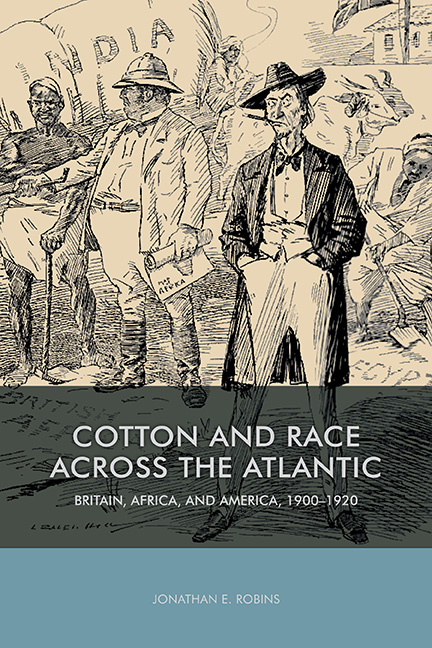Book contents
- Frontmatter
- Contents
- List of Illustrations
- Preface
- Abbreviations
- Introduction
- 1 The Cotton Crisis: Lancashire, the American South, and the Turn to “Empire Cotton”
- 2 “The Black Man's Crop”: The British Cotton Growing Association and Africa
- 3 “The Scientific Redemption of Africa”: Coercion and Regulation in Colonial Agriculture
- 4 “King Cotton's Impoverished Retinue”: Making Cotton a “White Man's Crop” in the American South
- 5 Cotton, Development, and the “Imperial Burden”
- Notes
- Bibliography
- Index
4 - “King Cotton's Impoverished Retinue”: Making Cotton a “White Man's Crop” in the American South
Published online by Cambridge University Press: 13 July 2019
- Frontmatter
- Contents
- List of Illustrations
- Preface
- Abbreviations
- Introduction
- 1 The Cotton Crisis: Lancashire, the American South, and the Turn to “Empire Cotton”
- 2 “The Black Man's Crop”: The British Cotton Growing Association and Africa
- 3 “The Scientific Redemption of Africa”: Coercion and Regulation in Colonial Agriculture
- 4 “King Cotton's Impoverished Retinue”: Making Cotton a “White Man's Crop” in the American South
- 5 Cotton, Development, and the “Imperial Burden”
- Notes
- Bibliography
- Index
Summary
American cotton-planters, proprietors of the greatest gold-producing staple in the world, are poor. They are practically in servitude. It is a tragedy of contemporary life that they who produce for the world the commodity without which modern civilization and industrial life could not proceed are themselves absolutely subservient and the poorest paid toilers in the United States.
—Daniel J. SullyDaniel J. Sully presented this assessment of the Southern cotton industry in “King Cotton's Impoverished Retinue,” the first of a three-part series for Cosmopolitan magazine in which the ruined cotton king called for revolutionary change in the growing and marketing of cotton. Sully added his voice to those of thousands of American farmers who were inspired by the cotton corners to push for higher cotton prices. Sully's own contribution to the South was ephemeral, but Southerners rallied around cotton as a symbol of economic oppression as well as economic opportunity. “Cotton populists” rekindled the agrarian political movement of the late nineteenth century, staging a revolt against their peripheral position in the global cotton textile industry. While they wanted to make more money from primary commodity production, they also sought to break the boom-and-bust cycle that the Sully corner exemplified.
Ellison D. Smith (better known as “Cotton Ed” Smith during his long career in the US Senate) argued in 1907 that the time had come for American farmers to earn a respectable income from cotton. The world had been transformed by technology, he observed:
Eighty years ago your grandfathers and mine never heard a steam whistle, they never heard a telephone bell, they never heard the click of a telegraph instrument; they never saw a machine that could print and fold and put on the markets of the world 10,000 copies hourly of a great daily that through the rural free delivery could be spread over an immense area in twenty-four hours. These are the forces that are spreading to the various districts of the earth and making the man in the backwoods as cosmopolitan as the man that walks the street, and keeps him in vital touch with the trend of the market.
Armed with information and access to markets, Smith claimed, “the toiler of the world is beginning to get an equal chance on the fighting line of life.”
- Type
- Chapter
- Information
- Cotton and Race across the AtlanticBritain, Africa, and America, 1900–1920, pp. 165 - 199Publisher: Boydell & BrewerPrint publication year: 2016

